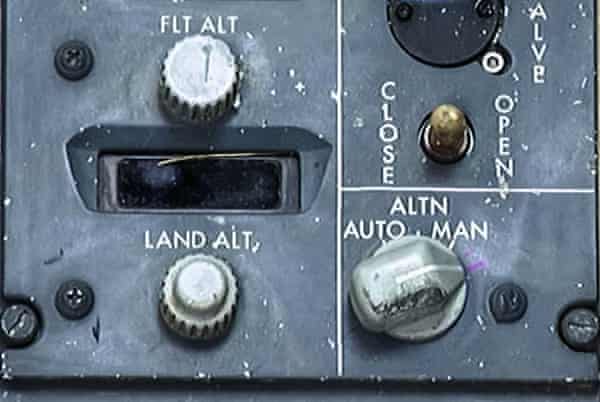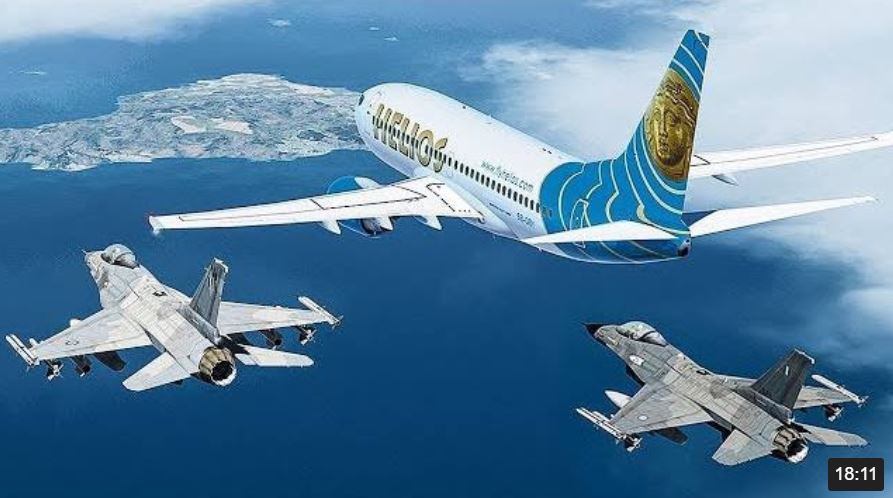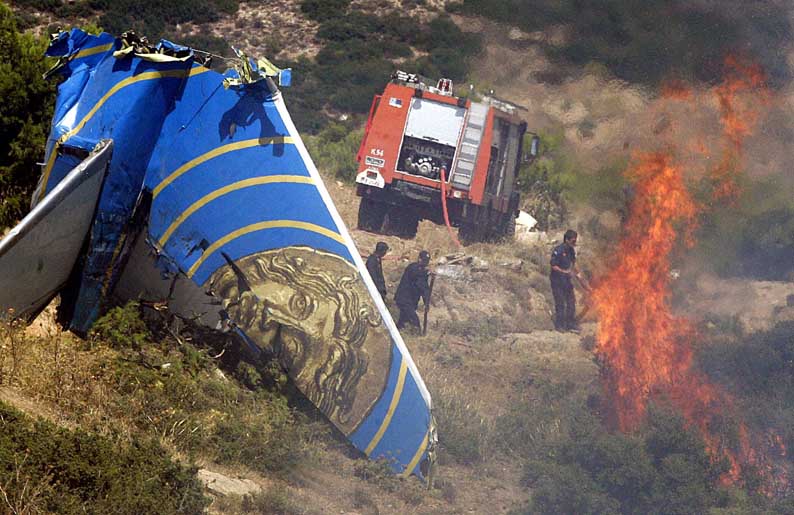14 August 2005 - Helios 522
Helios Airways Flight 522 was a scheduled passenger flight from Larnaca, Cyprus to Prague, Czech Republic, with a stopover to Athens, Greece, that crashed on 14 August 2005, killing all 121 passengers and crew on board. A loss of cabin pressurization incapacitated the crew, leaving the aircraft flying on autopilot until it ran out of fuel, and crashed near Grammatiko, Greece. It was the deadliest aviation accident in Greek history.

When the aircraft arrived from London earlier that morning, the previous flight crew had reported a frozen door seal, and abnormal noises coming from the right aft service door. They requested a full inspection of the door. The inspection was carried out by a ground engineer, who then performed a pressurization leak check. In order to carry out this check without requiring the aircraft's engines, the pressurization system was set to "manual." However, the engineer failed to reset it to "auto" on completion of the test.
After the aircraft was returned into service, the flight crew overlooked the pressurization system state on three occasions: during the pre-flight procedure, the after-start check, and the after take-off check. During these checks, no one on the flight deck noticed the incorrect setting. The aircraft took off with the pressurization system still set to "manual," and the aft outflow valve partially open.

As the aircraft climbed, the pressure inside the cabin gradually decreased. As it passed through an altitude of 12,040 feet (3,670 m), the cabin altitude warning horn sounded. The warning should have prompted the crew to stop climbing, but it was misidentified by the crew as a take-off configuration warning, which signals that the aircraft is not ready for take-off, and can only sound on the ground. The alert sound is identical for both warnings.
In the next few minutes, several warning lights on the overhead panel in the cockpit illuminated. One or both of the equipment cooling warning lights came on to indicate low airflow through the cooling fans (a result of the decreased air density), accompanied by the master caution light. The passenger oxygen light illuminated when, at an altitude of approximately 18,000 feet (5,500 m), the oxygen masks in the passenger cabin automatically deployed.
Shortly after the cabin altitude warning sounded, the captain radioed the Helios operations center and reported “the take-off configuration warning on” and “cooling equipment normal and alternate off line.” He then spoke to the ground engineer, and repeatedly stated that the “cooling ventilation fan lights were off.” The engineer (the one who had conducted the pressurization leak check) asked: “Can you confirm that the pressurization panel is set to AUTO?” However, the captain, already experiencing the onset of hypoxia's initial symptoms, disregarded the question, and instead asked in reply, “Where are my equipment cooling circuit breakers?” This was the last communication with the aircraft.
The aircraft continued to climb until it leveled off at FL340, approximately 34,000 feet (10,000 m). Between 09:30 and 09:40, Nicosia ATC repeatedly attempted to contact the aircraft, without success. At 09:37, the aircraft passed from Cyprus flight information region (FIR) into Athens FIR, without making contact with Athens ATC. Nineteen attempts to contact the aircraft between 10:12 and 10:50 also met with no response, and at 10:40, the aircraft entered the holding pattern for Athens Airport, at the KEA VOR, still at FL340. It remained in the holding pattern, under control of the auto-pilot, for the next 70 minutes.
Two F-16 fighter aircraft from the Hellenic Air Force 111th Combat Wing were scrambled from Nea Anchialos Air Base to establish visual contact. They intercepted the passenger jet at 11:24, and observed that the first officer was slumped motionless at the controls, and the captain's seat was empty. They also reported that oxygen masks were dangling in the passenger cabin.

At 11:49, flight attendant Andreas Prodromou entered the cockpit and sat down in the captain's seat, having remained conscious by using a portable oxygen supply. Prodromou held a UK Commercial Pilot Licence, but was not qualified to fly the Boeing 737. Crash investigators concluded that Prodromou's experience was insufficient for him to be able to gain control of the aircraft under the circumstances. Prodromou waved at the F-16s very briefly, but almost as soon as he entered the cockpit, the left engine flamed out due to fuel exhaustion, and the plane left the holding pattern and started to descend. Ten minutes after the loss of power from the left engine, the right engine also flamed out, and just before 12:04, the aircraft crashed into hills near Grammatiko, 40 km (25 mi; 22 nmi) from Athens, killing all 121 passengers and crew on board.

The cockpit voice recording begins roughly two hours after the last known pilot input recorded by the FDR. The aircraft's radios are still tuned to Nicosia ACC, and fragmented transmissions on the same frequency can be heard from other aircraft.
CVR TIME | LOCAL TIME | VOICES / (SOUNDS) / [EVENTS]
00:24 | 11:29:44 | (Unintelligible word). Descending 110 (unintelligible word) Edelwiess 672
03:19 | 11:32:39 | NICOSIA RADAR. Good morning from Bulgarian Charter 7867 maintaining FL 330. Estimate time TOMBI 0842
03:35 | 11:32:55 | (Microphone keying)
03:47 | 11:33:07 | Bulgarian Charter 7867 maintaining 330
03:56 | 11:33:16 | 0843 (probably Bulgarian Charter)
04:11 | 11:33:31 | (Unintelligible word) TOMBI 5662 Bulgarian Charter 7867
05:02 | 11:34:22 | Nicosia MVD 3007, good morning
05:11 | 11:34:31 | 3007 from URMM to PAFOS, maintaining 350 SQUAWK 1006. Estimate point TOMBI 0846
05:37 | 11:34:57 | Report TOMBI FL 350... (unintelligible word)... 5657... (unintelligible word)... 3007
09:12 | 11:38:32 | 121.2 Edelweiss 672
09:24 | 11:38:44 | (Cabin altitude warning horn increases in volume)
14:31 | 11:43:51 | Bulgarian Charter 7867 330, passing TOMBI
14:43 | 11:44:03 | Thank you-stand by for direct (unintelligible words)
16:52 | 11:46:12 | (3 unintelligible words, possibly Turkish)
17:00 | 11:46:20 | (Turkish words)
17:04 | 11:46:24 | Nicosia MVD 3007 Position TOMBI FL350 5657
17:21 | 11:46:41 | Nicosia proceed direct PAFOS report, ready for descent MVD 3007
19:11 | 11:48:31 | Nicosia MVD 3007 Requesting descent (2 chimes heard during transmission)
19:18 | 11:48:38 | MVD 3007 request descent
19:28 | 11:48:48 | Descending to FL 110, MVD 3007 Descent
19:31 | 11:48:51 | (2 chimes heard during transmission)
19:51 | 11:49:11 | (Continuous chime until 20:10)
20:12 | 11:49:32 | (Click sound is heard)
20:21 | 11:49:41 | (sound similar to movement in the cockpit)
20:30 | 11:49:50 | [Failure of Engine 1]
20:46 | 11:50:06 | (sound heard-possible seat adjustment or oxygen mask removal)
20:49 | 11:50:09 | (sound of oxygen flow during donning of mask, sound lasts until 20:58)
21:12 | 11:50:32 | Bank angle, bank angle (computerized voice)
21:17 | 11:50:37 | Bank angle, bank angle (computerized voice)
21:22 | 11:50:42 | (unknown sound)
21:25 | 11:50:45 | (Altitude alert warning)
21:32 | 11:50:52 | (unknown sound-possible air-noise)
21:38 | 11:50:58 | (Altitude alert warning)
21:44 | 11:51:04 | (Unintelligible word)
21:59 | 11:51:19 | (Sound of breathing in oxygen mask, sound lasts until 22:09)
22:28 | 11:51:48 | (Unknown noise similar to whistle.)
22:29 | 11:51:49 | Bank angle, bank angle (computerized voice)
22:30 | 11:51:50 | (Stick shaker)
22:36 | 11:51:56 | (Altitude alert warning)
23:21 | 11:52:41 | (Click sound)
24:44 | 11:54:04 | 242 good day Bulgarian Charter 7867
24:58 | 11:54:18 | Mayday, mayday, mayday, Helios Airways flight 522 Athens (unintelligible word)
25:13 | 11:54:33 | Overspeed warning until 26:29
25:45 | 11:55:05 | Mayday (very weak)
25:49 | 11:55:09 | Mayday (very weak)
26:07 | 11:55:27 | Traffic, traffic (computerized voice)
26:29 | 11:55:49 | (Overspeed warning)
26:48 | 11:56:08 | (Overspeed warning)
27:50 | 11:57:10 | (Overspeed warning)
28:04 | 11:57:24 | (Altitude alert warning)
28:08 | 11:57:28 | (Altitude alert warning)
28:24 | 11:57:44 | (Altitude alert warning)
29:00 | 11:58:20 | (Sound like oxygen rush or breathing)
29:07 | 11:58:27 | (Altitude alert warning)
29:33 | 11:58:53 | (Altitude alert warning)
29:43 | 11:59:03 | (10000 ft Cabin altitude warning horn stops)
29:46 | 11:59:06 | (7 chimes similar to flight attendant call (to enter cockpit?))
29:55 | 11:59:15 | (Unknown sound)
29:58 | 11:59:18 | (Oxygen flow sound)
30:02 | 11:59:22 | (Click sound)
30:06 | 11:59:26 | (Sound similar to oxygen mask being inflated or deflated.)
30:19 | 11:59:39 | (Sound similar to oxygen mask being inflated or deflated.)
30:23 | 11:59:43 | (Sound similar to oxygen mask being inflated or deflated.)
30:27 | 11:59:47 | [Failure of Engine 2, end of tape]
Impact occurs roughly four minutes later. Based on the presumed use of an emergency code to enter the flight deck, it is assumed that the male voice on the recording belonged to a cabin crew member, specifically the only male flight attendant aboard the airplane. It is possible based on the sound recorded at 29:46 that at least one other member of the cabin crew was conscious as well. It is unlikely that any trained member of the cabin crew would have waited over two hours without hearing from the cockpit crew before entering the cockpit, but without audio from the preceding two hours of the flight, it is not known what took place in the cockpit or the cabin for most of the emergency, nor is it known if the cockpit entry recorded on the CVR was the only time during the flight that a member of the cabin crew entered the cockpit.

